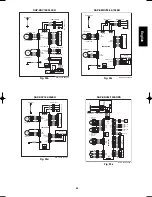
15
English
3-7. Insulation of Refrigerant Tubing
To prevent heat loss and wet floors due to dripping of con-
densation,
both tubes must be well insulated with a
proper insulation material.
The thickness of the insulation should be a minimum
8 mm. (Fig. 17)
3-8. Taping the Tubes
(1) At this time, the 2 refrigerant tubes (and electrical wire
if local codes permit) should be taped together with
armoring tape. The drain hose may also be included
and taped together as 1 bundle with the tubing.
(2) Wrap the armoring tape from the bottom of the outdoor
unit to the top of the tubing where it enters the wall. As
you wrap the tubing, overlap half of each previous tape
turn. (Fig. 18)
(3) Clamp the tubing bundle to wall, using 1 clamp approx.
every 120 cm.
Do not wind the armoring tape too tightly, since this will
decrease the heat insulation effect. Also, be sure the con-
densation drain hose splits away from the bundle and drips
clear of the unit and the tubing.
3-9. Finishing the Installation
After finishing insulating and taping over the tubing, use
sealing putty to seal off the hole in the wall to prevent rain
and draft from entering. (Fig. 19)
NOTE
IMPORTANT
Indoor unit
Outdoor unit
Spanner
Torque wrench
Fig. 15
Insulation
Min.
8 mm
Thickness:
min. 8 mm
Fig. 17
Fig. 18
Clamp
Insulated tubes
Apply putty here
Tubing
Fig. 19
CAUTION
After a tube has been insulated,
never try to bend it into a
narrow curve, as this may
cause the tube to break or
crack.
Insulation
Fig. 16
CAUTION
Be sure to match refrigerant
tubing and electric wiring
between indoor and outdoor
units.
08-253 CMRV3146EH_OU EN 10/14/08 2:39 PM Page 15














































